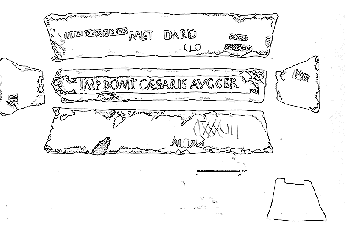

During the 1993 excavation season (Discovery Day), CCE divers came upon the typical remains of the wreckage site of a merchantman. It is believed that the vessel ran aground over the already inundated, tumbling structure of the ancient harbour breakwater. This theory is supported by the finding of a piece of coiled lead sheathing stripped off the keel of the wreckage and torn-off bolts. Further, having only metal objects at the site of the wreckage (as was found here) is typical for wrecks foundering in shallow, turbulent waters over a hard substrate.
The most surprising items recovered from this site are a group of lead ingots (Photo of Lead Ingots); all are of the same mold and are undoubtedly from the wrecked vessel. Two of these ingots still retain their original form and imprinted markings, including the imperial imprint on their crest, which can easily be read as: IMP.DOMIT.CAESARIS.AUG.GER.
This imprint would date these ingots sometime between 83 CE (the year the Roman Emperor Domitianus was entitled "Germanicus" following his victory in Germany) and 96 CE, his last year as Emperor. Other molded letters on the sides of the ingots, MET.DARD, might indicate that the mines where they were cast were located at Cosovo, Dardania of the Roman era.
The date of the wreckage combined with the fact that the wreckage occurred over the lee side of the lighthouse indicates that the harbor breakwaters were at least partially submerged below the waves by the first century. However, if one also considers that, during the first century, Josephus wrote his composition referring to Sebastos as an intact, properly operating complex, it appears that the placement and date of the wreck indicates the harbor's subsidence may have been sudden rather than gradual.